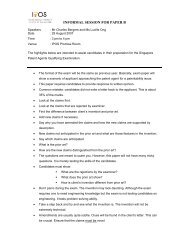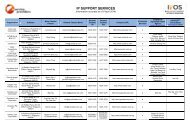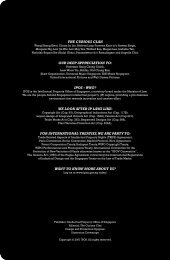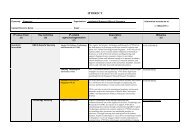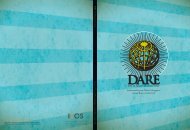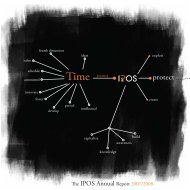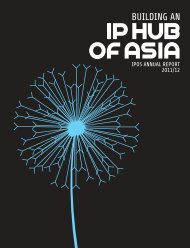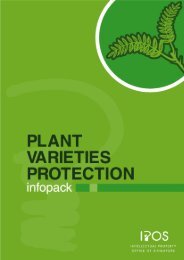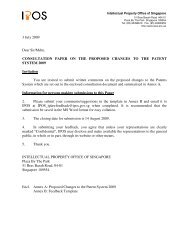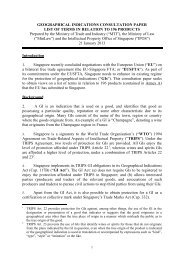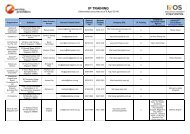Shape Marks - Intellectual Property Office of Singapore
Shape Marks - Intellectual Property Office of Singapore
Shape Marks - Intellectual Property Office of Singapore
- No tags were found...
You also want an ePaper? Increase the reach of your titles
YUMPU automatically turns print PDFs into web optimized ePapers that Google loves.
<strong>Shape</strong> marks6 REGISTRABILITY OF SHAPE MARKSIn examination <strong>of</strong> the registrability <strong>of</strong> shape marks, the first hurdle will be whether theshape falls foul <strong>of</strong> Section 7(3) <strong>of</strong> the Trade <strong>Marks</strong> Act.It must be noted that if any <strong>of</strong> the criteria listed in Section 7(3) is satisfied, the signcannot be registered as a trade mark. Furthermore, even substantial evidence <strong>of</strong> use willnot overcome the fundamental objection that the shape cannot be registered as a trademark.(a) Section 7(3)(a) - <strong>Shape</strong>s resulting from the nature <strong>of</strong> the goodsThis ground prevents the registration <strong>of</strong> shapes that result from the nature <strong>of</strong> thegoods. It is not concerned to prevent registration <strong>of</strong> marks consisting <strong>of</strong> the shapes <strong>of</strong>the goods themselves as shapes <strong>of</strong> distinctively shaped goods can function as a trademark, but rather, shapes that result from the nature <strong>of</strong> the goods.The nature <strong>of</strong> the goods refers to their essential qualities or innate characteristics. Forexample, a sign consisting <strong>of</strong> the shape <strong>of</strong> a banana for bananas would be a shape,which results from the nature <strong>of</strong> the goods themselves. So too, would a signconsisting <strong>of</strong> a bunch <strong>of</strong> bananas for bananas. To assess whether a shape is onewhich results from the nature <strong>of</strong> the goods, the Registrar will look at the goods todetermine their nature and consider the following:(i) the extent to which the shape is regarded as the “normal” shape <strong>of</strong> the goods;(ii) where the goods have a “uniform” shape, whether the shape is a variation fromthe “uniform” shape; if so, the shape may not be objectionable on the groundthat it results from the nature <strong>of</strong> the goods;(iii) where the goods come naturally in a range <strong>of</strong> shapes, then any one <strong>of</strong> the usualshapes will be open to objections.ExampleA picture <strong>of</strong> a lemon as a proposed trade mark for lemons would not be acceptablebecause the sign would consist exclusively <strong>of</strong> a shape which results from the nature <strong>of</strong>the goods themselves – lemons. Likewise a picture <strong>of</strong> lemons on the branch, or asilhouette <strong>of</strong> a lemon.If the goods were lemon juice, then a picture <strong>of</strong> a lemon should not fall foul <strong>of</strong> thisprovision. Likewise if the proposed mark was a yellow plastic container in the shape<strong>of</strong> a lemon, the shape may not be objected to on the ground that it results from thenature <strong>of</strong> the goods.Where the specification is wide, “the goods” refer to any <strong>of</strong> the goods in respect <strong>of</strong>which the mark is sought to be registered. Thus, a picture <strong>of</strong> a banana for fruit wouldbe just as objectionable as a picture <strong>of</strong> a banana for bananas.Version 1 (13 January 2006) Page 7 <strong>Intellectual</strong> <strong>Property</strong> <strong>Office</strong> <strong>of</strong> <strong>Singapore</strong>



